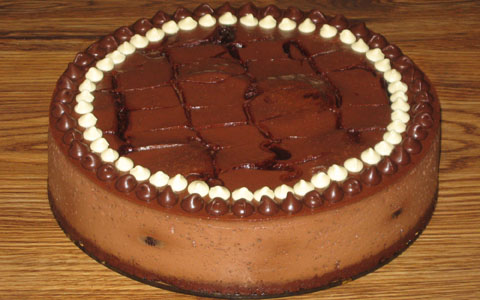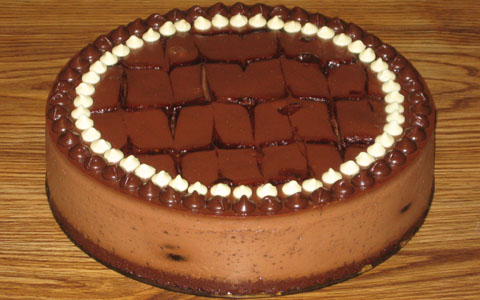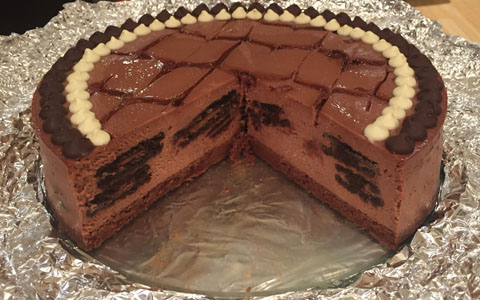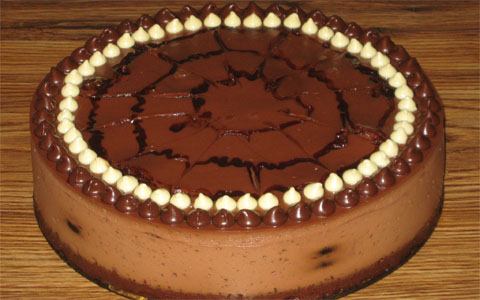|
|
 |
Baked Chocolate Cheesecake—Prototype 22 (7-Way Chocolate):
3-Cheese Blend (3CT-1NC-2YG):
Prepare ahead of time 16 ounces of yogurt cheese, derived from one 32-ounce
container of nonfat yogurt. If the resulting yogurt cheese falls below 16
ounces, add back enough of the whey (that was strained out from the yogurt) to
make up the difference. To this yogurt cheese combine 24 ounces of whipped,
lowfat cottage cheese and 8 ounces of softened Neufchatel cheese ("light
cream cheese").
Grease a 9 1/2" (or 9") pan, but do not wrap foil around it until just
before the batter is added (spreading the crust in an already wrapped pan can
result in greater disturbance to the foil, thus increasing leakage risks).
Chocolate Crust:
4 oz. semi-sweet chocolate, melted
3/8 cup granulated sugar
2 tablespoons cocoa powder
8 oz. (1 cup) 3-cheese blend (see above)
1 teaspoon vanilla
2 oz. finely ground All-Bran
Place the resulting mixture in the greased pan and pre-bake without tub at 300
degrees for 5-10 minutes, depending on the mixture's thickness (closer to 10
minutes if thin enough to be fully distributed across the pan's bottom by gentle
shaking, closer to 5 minutes if thick enough to require spreading out this
mixture by pressing on it with a utensil and/or fingers), then cool enough to
comfortably touch at least the pan's upper sidewall.
Chocolate Batter:
1 3/4 cups granulated sugar
3/8 cup cocoa powder
40 oz. (5 cups) 3-cheese blend (see above)
1 1/2 teaspoons xanthan gum
2 teaspoons vanilla
6 eggs
Double-chocolate sandwich cookies (such as Newman's Own), about 2 dozen
Expect just over 7 cups of the resulting chocolate batter, but do not add this to
the pan all at once. Rather, this needs to be done in two installments. Wrap the
pan in foil just before adding the first installment. Minimize the foil's
disturbance in order to minimize its leakage risk.
For the first installment, start off by gently scooping some batter into the
pan just until the crust is fully coated. Afterwards, lay flat about 6 cookies
onto this batter. Then add more batter, coating these cookies well. Lay flat
another 6 cookies, but try to place them such that they are not overlapping any
of the first layer of cookies. Coat this second layer as well with additional
batter. Next, add a third layer of about 6 cookies, laying them flat also. Try
to avoid overlapping the second layer. However, it is okay (and encouraged) if
they are directly above the first layer of cookies. Add more batter, coating the
third layer. Finally, add a fourth layer of about 6 cookies—laying these
flat too—and try to avoid overlap with the third layer cookies, but feel
free to position the fourth layer's directly above those of the second. Fully
coat this final cookie layer, and—with the rest of the batter less
roughly 1 1/2 to 2 cups—try to make the top surface of the batter
reasonably level within the pan (it's okay if some of the cookies float upward
and protrude a bit, but make sure that they are still lying horizontally).
After this is done, bake the pan with its contents at 325 degrees for 30
minutes, in a tub filled with at least about 1/2 inch of boiling water. To
reduce spillage risks, do not fill the tub all the way at this point, because
the whole tub-and-pan assembly is going to need to be removed from the oven (in
order to comfortably add contents to the pan) for the next installment.
For that second (final) installment, gently add the remaining 1 1/2 to 2 cups of
batter to the pan (no additional cookies at this point). Then add some chocolate
syrup (such as Trader Joe's Organic Midnight Moo)—about a few tablespoons
altogether—by pouring thick, parallel stripes onto the top surface in the
pan. Then pull a knife in perpendicular directions through these dark stripes in
the lighter-colored batter (just deeply enough for the uppermost installment's
surface) in order to produce a wavy, swirl pattern. Do all this as neatly as
possible (try to avoid cutting into the lower installment underneath). (If
desired, try a different chocolate syrup pattern, such as concentric circles.
See photo and comments below.)
After this last installment is in place, return the entire pan-and-tub assembly
to the oven. At this point, fill up the tub more generously with boiling water.
Resume baking, but with the oven temperature lowered to 300 degrees, for about
another 75 minutes (based upon usage of a 9 1/2" pan).
Afterward, shut the oven off, and leave its door slightly ajar, with the
cheesecake still inside—and in the tub—for an hour. Next, remove the
cheesecake from the oven and tub. Now, for the final chocolate touch, add a
border of chocolate chips, semi-sweet and white, around the edge of this
cheesecake (see photo below). Continue to cool it down at room temperature for
another two hours. After doing so, remove the cheesecake from pan and
refrigerate.


(The first cheesecake shown here made in January, the second one in March,
of 2018)
|
|

|




